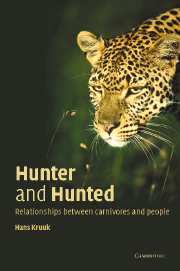Book contents
- Frontmatter
- Contents
- Preface
- 1 Turning the other cheek
- 2 Carnivore society: hermits and communes
- 3 The quarry of the hunter
- 4 Man the hunted
- 5 Competitors and carriers
- 6 History of a conflict
- 7 What is the use?
- 8 Wolves with human souls: pets
- 9 Carnivores and neighbours: effects on prey
- 10 Crying wolf: anti-predator behaviour
- 11 Carnivores in culture
- 12 The future
- Epilogue
- References
- Index
- References
References
Published online by Cambridge University Press: 08 January 2010
- Frontmatter
- Contents
- Preface
- 1 Turning the other cheek
- 2 Carnivore society: hermits and communes
- 3 The quarry of the hunter
- 4 Man the hunted
- 5 Competitors and carriers
- 6 History of a conflict
- 7 What is the use?
- 8 Wolves with human souls: pets
- 9 Carnivores and neighbours: effects on prey
- 10 Crying wolf: anti-predator behaviour
- 11 Carnivores in culture
- 12 The future
- Epilogue
- References
- Index
- References
- Type
- Chapter
- Information
- Hunter and HuntedRelationships between Carnivores and People, pp. 227 - 240Publisher: Cambridge University PressPrint publication year: 2002



